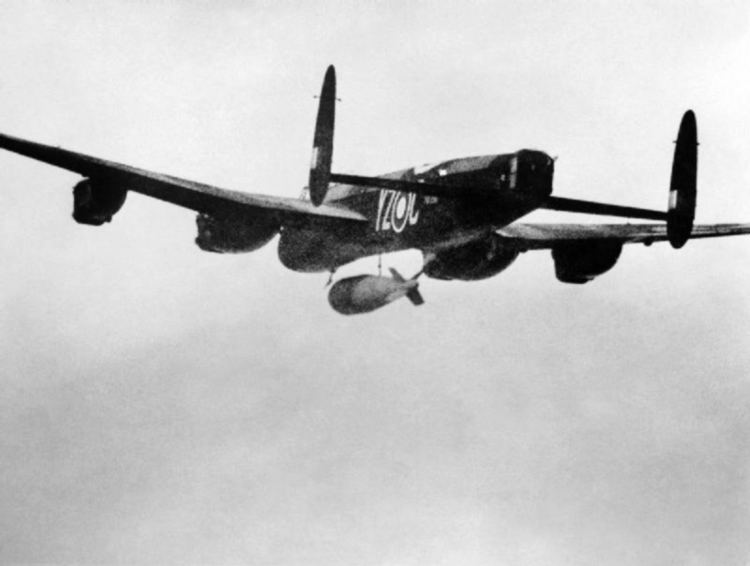Type Earthquake bomb In service 1945 Wars World War II | Place of origin United Kingdom Used by Royal Air Force Designer Barnes Wallis | |
 | ||
The Grand Slam was a 22,000 lb (10,000 kg) earthquake bomb used by RAF Bomber Command against strategic targets during the Second World War. It was the most powerful non-atomic bomb used in the war.
Contents
Known officially as the Bomb, Medium Capacity, 22,000 lb, it was a scaled-up version of the Tallboy bomb and closer to the original size that the bombs' inventor, Barnes Wallis, had envisaged when he first developed his earthquake bomb idea. It was also nicknamed "Ten ton Tess".
Development
When the success [of the Tallboy bomb] was proved, Wallis designed a yet more powerful weapon… This 22,000 lb. bomb did not reach us before the spring of 1945, when we used it with great effect against viaducts or railways leading to the Ruhr and also against several U-boat shelters. If it had been necessary, it would have been used against underground factories, and preparations for attacking some of these were well advanced when the war ended.
On 18 July 1943, work started on a larger version of the Tallboy bomb, which became the Grand Slam. As with the original Tallboy, the Grand Slam's fins generated a stabilizing spin and the bomb had a thicker case than a conventional bomb, which allowed deeper penetration. After the hot molten Torpex was poured into the casing, the explosive took a month to cool and set. Like the Tallboy, because of the low rate of production and consequent high value of each bomb, aircrews were told to land with their unused bombs on board rather than jettison them into the sea if a sortie was aborted.
After release from the Avro Lancaster B.Mk 1 (Special) bomber, the Grand Slam would reach near-supersonic speed, approaching 1,049 ft/s (320 m/s), 715 mph (1150 km/h). When it hit, it would penetrate deep underground before detonating. The resulting explosion could cause the formation of a camouflet (cavern) and shift the ground to undermine a target's foundation.
Unlike Tallboy, Grand Slam was originally designed to penetrate concrete roofs. Consequently, it was more effective against hardened targets than any existing bomb.
The first Grand Slam was tested at the Ashley Range in the New Forest, on 13 March 1945.
Grand Slam combat operations
By the end of the war, 42 Grand Slams had been dropped on active service.
Post–war operations
Beginning in March 1946, Project Ruby was a joint Anglo–American project to investigate the use of penetration bombs against heavily protected, concrete targets. The target selected was the Valentin submarine pens, that had been rendered unusable and abandoned since 617 Squadron's attack on 27 March 1945. Grand Slams were carried by Lancasters from No. 15 Squadron RAF and US Boeing B-29 Superfortress. Around 140 sorties were flown, testing a range of different bombs.
Survivors
Five complete Grand Slam bombs are preserved and displayed in the United Kingdom at the RAF Museum, London; Brooklands Museum; RAF Lossiemouth; Dumfries and Galloway Aviation Museum and the Battle of Britain Memorial Flight Visitors' Centre at RAF Coningsby. Main portions of these bombs, without their lightweight tails, can be seen at the Kelham Island Museum in Sheffield and Yorkshire Air Museum at Elvington.
A T-14 bomb (an American-made variant of the Grand Slam) is displayed at the Air Force Armament Museum in the United States.
